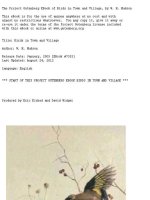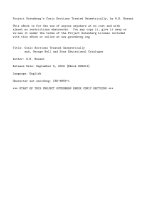Logarithms self taught by peter h selby
Bạn đang xem bản rút gọn của tài liệu. Xem và tải ngay bản đầy đủ của tài liệu tại đây (34.25 MB, 133 trang )
Senior Research Engineer
General Dynamics/Astronautics
Formerly Flight Training Supervisor
Convair Division, San Diego
...
•1•
•1•
•••***•••
•*•
.....•!.''..
•*•
..''..
.'.
.•.'!.*.•
McGraw-Hili Book Compony, New York· Toronto· London
•1•
www.pdfgrip.com
To
"Uncle Dudley"
who taught me to
enjoy mathematics
LOGARITHMS SELF-TAUGHT
Copyright
©
1964 by McGraw-Hili, Inc.
All righh reserved, including the right to reproduce this book,
or any portion thereof, in any form, without permission by the
Publisher.
Printed in the United States of America
Library of Congress Catalog Card Number 64-16492
345678910 MUMU 7654321
ISBN 07-056068-4
www.pdfgrip.com
PREFACE
You will find the material in this book presented in a different
way than you are accustomed to in an ordinary textbook. The
first thing you will notice is that you are given only a small
amount of information at a time, then immediately asked an
appropriate question to help you find out how much you have
understood, just as an individual tutor would do. The answer
you select in each case determines the item of information you
will be given next; hence your route through the course. This
is a special kind of self-teaching technique known as "programmed instruction" or "auto-instruction."
Your rate of progress-the time you spend and the amount of
material you read-is, therefore, up to you. You can go as rapidly
or as slowly as your aptitude and inclination permit.
If this is the first time you have studied a subject presented
in this new way, you should find it an interesting way to learn.
www.pdfgrip.com
Whom This Course Is For
This book is intended primarily for the following two groups:
1.
Those individuals who want or need to know something about
the practical techniques of solving mathematical problems
which require, or can be simplified by the use of, logarithms
(either numerical or trigonometric) and who are approaching
this subject for the first time.
2. Those who may have learned something about logarithms in
high school or college (perhaps a long while ago), but who
have had little occasion to use their knowledge since and now
need a brief review of the subject in order to apply it in their
work or to further study.
www.pdfgrip.com
CONTENTS
Preface
Whom This Course Is For
What You Can Expect to Learn from This Course
What the Reader Needs to Know about This Book
Part I. Logarithms of Numbe"
Exponents
5
What Logarithms Are
8
14
Use of the Numerical Log Tables
Determining the Characteristic of a Number
The Two Parts of a Log
19
Practice in Finding Logarithms
26
29
Rule for Determining the Characteristic
Rules Governing Exponents (Logs)
30
41
Practice Problems
Review of Numerical Logs
42
Part II. Trigonometry and Logarithms Combined
49
Use of the Log-Trig Tables
50
A Sample Problem
Some Practice Problems
54
Final Review
55
Self-quiz
57
Numerical Logs
Log Trigonometry
57
61
Answers to Self-quiz
63
Glossary of Terms
18
44
66
Supplementary Problems
68
Appendix A. Logarithms of Selected Numbe"
73
Appendix B. Logarithms of the Trigonometric Functions
www.pdfgrip.com
76
What You Can Expect to Learn from This Course
This specialized course of instruction is by no means allinclusive. It is intended to familiarize you with the basic con,-'epts underlying the use of logarithms, both numerical and
trigonometric, and to assist you in learning how to apply these
concepts in solving problems.
Specifically, at the conclusion of this course, you should be
generally familiar with the theory and use of common logarithms
and the practical techniques of solving plane right triangles with
the aid of a table of logarithms of the trigonometric functions.
You should also be able to demonstrate your knowledge by scoring at least 40 on the self-administered quiz found at the back of
this book.
It is assumed that the reader has had a first course in algebra
and a course in trigonometry at some time in his educational
career. However, the author has endeavored to explain all
needed terms and concepts herein. (Be sure to look in the
Glossary, page 66, for an explanation of any words or expressions
that are not familiar to you. )
You will not need to have studied trigonometry in order to
understand the explanation concerning the theory and use of
www.pdfgrip.com
common logarithms. However, if you wish to gain a working
knowledge of how logarithms of the trigonometric functions are
used to aid in the solution of problems in trigonometry, then you
may wish to procure a copy of "Trigonometry Self-Taught," a
companion volume which will supply the necessary background
for this course, or to take one of the courses in trigonometry
available through schools.
If a general familiarity with the theory and use of logarithms
is as much as you want (or need), practicing what this program
will teach you should in time make you skillful in using logarithms
to solve practical problems in multiplication, division, raising
numbers to higher powers, or extracting roots. You also will
develop a practical skill in solving plane right triangles through
the use of logarithms.
On the other hand, if finishing this program merely whets
your appetite-so that you want to learn more about logarithms,
other applications and other kinds of logarithms-then by all
means seek out a good teacher and a good standard textbook.
This program will at least have served to start you on a fascinating
highway that you can follow as far as you care to travel.
www.pdfgrip.com
What the Reader Needs to Know about This Book
This is no ordinary book. Although the pages are numbered consecutively, they are not intended to be read consecutively.
At the bottom of each page, you will be told which page to
turn to next. Follow these instructions and you will have no
trouble staying on the intended path. This will aid us in presenting just the information you need to help you understand the
subject matter.
To begin, proceed to page 1.
www.pdfgrip.com
Part I
Logarithms of Numbers
Anyone who has ever had occasion to multiply 6.41 X 0.00127
X 6984.3 X 1.002, and then possibly divide the product by 974.2 X
0.0394, is in the market for logarithms (or "logs" as the name
usually is abbreviated) whether he knows it or not. They are of
considerable aid in multiplying, dividing, and raising numbers to
higher powers.
As a word of encouragement, if you have not hitherto been
exposed to the subject, or if you have been dazzled by its
imagined difficulties, do not be afraid! There is nothing very
mysterious about logs. They are not a disease (not in the ordinary sense at least) and, in any case, not a contagious one.
Perhaps you have learned something about them already.
Let's see if you can pick the best answer to this question : Of
what use are logarithms?
Logarithms aid in the multiplication and division
of numbers.
Logarithms can be used to add long sums of
numbers quickly.
I can't answer because I don't know what a logarithm is.
www.pdfgrip.com
PAGE 5
PAGE 3
PAGE 7
2
You're out of bounds.
Apparently you didn't follow instructions. Nowhere in this
book are you directed to this page.
If you will recall, we pointed out that you must follow the
directions at the bottom of each page in order to stay on the right
path. This book will not make much sense if the pages are read
consecutively.
Please return to page 1 and try again.
www.pdfgrip.com
FROM PAGE 1
Your answer:
3
logarithms can be used to add long sums
of numbers quickly.
No. Unfortunately, logs are of no help whatever in adding
numbers. They are useful in many ways, but addition is not one
of them.
You remember we said at the outset that logarithms are a
considerable aid in multiplying, dividing, and raising numbers to
higher powers. We did not say anything about addition or subtraction, and these are quite different processes from multiplication and division.
Read page 1 again; then choose the correct answer.
www.pdfgrip.com
4
FROM PAGE S
Your answer:
9 is the base and 2 is the exponent.
No, apparently you've missed the key point. In describing
exponents, we stated that they were located to the right and
slightly above another number (the base). Probably you've
confused the two in this case because the numbers we used, 2
and 9, are the same numbers we used in first discussing exponents
on page 5, but now we are using them in a different relationship!
Return to page 5, look over the explanation again, and select
the correct answer.
www.pdfgrip.com
FROM PAGE 1
Your answer:
5
Logarithms aid in the multiplication and
division of numbers.
You're rightl Of course they do; that's the whole idea.
They also help in raising numbers to higher powers, and they
have other uses as well. But first and foremost we think of them
as being useful in mathematical problems-many of which occur
in our daily lives-where we are confronted with the rather
tedious task of multi.plying and dividing long numbers.
Actually, logarithms are nothing but exponents. In case you
have forgotten what an "exponent" is, it is the small number
placed to the right and slightly above another number to indicate
the power to which the second number is to be raised; that is,
the number of times the second number is to be multiplied by
itself.
Thus, in the term 92 (which we commonly read as "nine
squared"), 2 is the exponent and 9 is called the "base." The
term 92 may also be read "nine to the second power." Similarly,
43 (commonly read "four cubed") may be read as "four to the
third power." We could, in fact, have the number 4 raised to
any power. These power-indicators are exponents.
Now, let's see if you've got this matter of exponents and
bases sorted out in your mind. In the expression 29 ,
9 is the base and 2 is the exponent.
PAGE 4
2 is the base and 9 is the exponent.
I'm still not clear which is which.
PAGE 8
www.pdfgrip.com
PAGE 6
FROM PAGE 5
Your answer:
6
I'm still not clear which is which.
Come now, it's not that complicated. There are only two
numbers involved here-one the base and the other the exponent.
By our definition the exponent is the one slightly raised and to
the right of the other number (the base).
With this in mind, read the question on page 5 again and
pick the correct answer this time.
www.pdfgrip.com
7
FROM PAGE 1
Your answer:
I can't answer because I don't know what a
logarithm is.
Well, if that answer correctly states the situation, then you're
right-about the state of your knowledge, at least. But come
now. You don't really have to have any great knowledge of
logarithms to answer that question, do you? All you need to
know is cont:lined in the opening paragraph of this subject.
Turn back to page 1, read the opening paragraph again, then
select a better answer.
www.pdfgrip.com
FROM PAGE 5
Your answer:
8
2 is the base and 9 is the exponent.
Good! You weren't fooled by the fact that we used the same
numbers as before but interchanged their positions.
Now in discussing exponents thus far, we have selected our
base numbers more or less at random. Suppose for a moment
that, instead of choosing a base at random (such as 4 in the expression 43 or 9 in the expression 92 ), we choose the specific
base 10. Then, raising 10 to various powers we get
= 10
1()2 = 100
101
103
= 10,000
105 = 100,000
104
= 1,000
and so on.
The power indicators I, 2, 3, 4, 5, etc., are exponents. And
once we select a specific base for raising to various powers, we
have a system of logarithms. Using the base 10, as we did above,
we get a system known as "common log.s." Ihis is the sy~
used most commonly (hence the name) and the only one with
~ich we will beSQDcemed.
Considering the foregoing, then, we can define a logarithm
as follows: The logarithm of a number is the power to wbicluz
given base must be wised in order to produce that nwnber. Thus
the exponents in the above example may be called logs.
Pick the right answer below, and let's see if you're still with
us.
Common logs are simply powers of the base 10.
PAGE 10
I still don't understand the definition of a log.
PAGE 9
Common logs is the only system of logs there is.
PAGE 12
www.pdfgrip.com
FROM PAGE 8
Your answer:
9
I still don't understand the definition of a log.
You probably understand more than you realize, but let's take
another look at that definition. It runs as follows:
The logarithm of a number is the power to which a given
base must be raised in order to produce that number.
Let's take the number 10,000. To what power would you
have to raise 10 in order to produce this number? You'd have
to raise it to the fourth power, wouldn't you? In this case, 10,000
is the number we wish to produce, 10 is the base, and 4 is the
power to which the base must be raised in order to produce
(get) 10,000. That's clear enough, isn't it?
Now, re-read the explanation on page 8 and select the correct answer.
www.pdfgrip.com
FROM PAGE 8
Your answer:
10
Common logs are simply powers of the
bose 10.
Very good; you've got the point. Now let's extend this idea
a bit.
Selecting at random one of the foregoing examples, namely,
103
= 1,000
we may also write this expression as follows:
10glO 1,000 = 3.
We read this: The log of 1,000 to the base 10 equals 3, or
simply, the log of 1,000 is 3, since we have adopted the base 10
permanently and it is therefore understood. Similarly,
log 10 = 1
log 100 = 2
log 10,000
=4
log 100,000 = 5
and so on.
However, we seldom multiply and divide in multiples of 10;
hence logarithms rarely are whole numbers. For example, suppose we wish to know the log of the number 143. Have you any
idea what it will be? Think about it for a moment, and then
see if you can pick the correct answer below.
The log of 143 will be greater than 3.
I have no idea what it would be.
The log of 143 would be greater than 2 but less
than 3.
www.pdfgrip.com
PAGE 11
PAGE 15
PAGE 17
FROM PAGE 10
Your answer:
11
The log of 143 will be greater than 3.
Surely not, for the log of 1,000 is 3, and our number is less
than 1,000. In order for the log of a number to be greater than
3, the number itself must be greater than 1,000.
Return to page 10 and try again.
www.pdfgrip.com
FROM PAGE 8
Your answer:
12
Common logs is the only system of logs
there is.
No; if you believe this, then we've left you with the wrong
impression. In selecting the base 10 for our system of logs, we
didn't say this was the only possible system. What we said was
that selecting a specific base resulted in the production of a (just
one) system of logs. However, for every base you select, you get
a different system of logs. The system based on 10 just happens
to be the one most convenient for most of our calculating because
it ties in very happily with our decimal numbering system. But
the selection of any consistent base, though it might result in a
rather complicated system, will yield a family of logarithms.
With this thought in mind, return to page 8 and choose a
better answer.
www.pdfgrip.com
Appendix A
0
1
--- - - -
-
LOGARITHMS OF NUMBERS
7
6
8
9
4
5
Q)
- - - - - - - - - - - - - - - -- - -- - 2
10 00000
11 04139
12 07918
11394
14613
00432
04532
08279
11727
14922
00860
04922
08636
12057
15229
01284
05308
08991
12385
15534
01703
05690
09342
12710
15836
02119
06070
09691
13033
16137
02531
06446
10037
13354
16435
02938
06819
10380
13672
16732
03342
07188
10721
13988
17026
03743
07555
11059
14301
17319
15
16
17
18
19
17609
20412
23045
25527
27875
17898
20683
23300
25768
28103
18184
20952
23553
26007
28330
18469
21219
23805
26245
28556
18752
21484
24055
26482
28780
19033
21748
24304
26717
29003
19312
22011
24551
26951
29226
19590
22272
24797
27184
29447
19866
22531
25042
27416
29667
20140
22789
25285
27646
29885
20
21
22
23
24
30103
32222
34242
36173
38021
30320
32428
34439
36361
38202
30535
32634
34635
36549
38382
30750
32838
34830
36736
38561
30963
33041
35025
36922
38739
31175
33244
35218
37107
38917
31387
33445
35411
37291
39094
31597
33646
35603
37475
39270
31806
33846
35793
37658
39445
32015
34044
35984
37840
39620
25
26
27
28
29
39794
41497
43136
44716
46240
39967
41664
43297
44871
46389
40140
41830
43457
45025
46538
40312
41996
43616
45179
46687
40483
42160
43775
45332
46835
40654
42325
43993
45484
46982
40824
42488
44091
45637
47129
40993
42651
44248
45788
47276
41162
42813
44404
45939
47422
41330
42975
44560
46090
47567
30
31
32
33
34
47712
49136
50515
51851
53148
47857
49276
50651
51983
53275
48001
49415
50786
52114
53403
48144
49554
50920
52244
53529
48287
49693
51055
52375
53656
48430
49831
51188
52504
53782
48572
49969
51322
52634
53908
48714
50106
51455
52763
54033
48855
50243
51587
52892
54158
48996
50379
51720
53020
54283
35
36
37
38
39
54407
55630
56820
57978
59106
54531
55751
56937
58092
59218
54654
55871
57054
58206
59329
54777
55991
57171
58320
59439
54900
56110
57287
58433
59550
55023
56229
57403
58546
59660
55145
56348
57519
58659
59770
55267
56467
57634
58771
59879
55388
56585
57749
58883
59988
55509
56703
57864
58995
60097
40
41
42
43
44
60206
61278
62325
63347
64345
60314
61384
62428
63448
64444
60423
61490
62531
63548
64542
60531
61595
62634
63649
64640
60638
61700
62737
63749
64738
60746
61805
62839
63849
64836
60853
61909
62941
63949
64933
60959
62014
63043
64048
65031
61066
62118
63144
64147
65128
61172
62221
63246
64246
65225
45
46
47
48
49
65321
66276
67210
68124
69020
65418
66370
67302
68215
69108
65514
66464
67394
68305
60197
65610
66558
67486
68395
69285
65706
66652
67578
68485
69373
65801
66745
67669
68574
69461
65896
66839
67761
68664
69548
65992
66932
67852
68753
69636
66087
67025
67943
68842
69723
66181
67117
68034
68931
69810
50
51
52
53
54
69897
70757
71600
72428
73239
69984
70842
71684
72509
73320
70070
70927
71767
72591
73400
70157
71012
71850
72673
73480
70243
71096
71933
72754
73560
70329
71181
72016
72835
73640
70415
71265
72099
72916
73719
70501
71349
72181
72997
73799
70586
71433
72263
73078
73878
70672
71517
72346
73159
73957
55
56
57
58
59
74036
74819
75587
76343
77085
74115
74896
75664
76418
77159
74194
74975
75740
76492
77232
74273
75061
75815
76567
77305
74351
75128
75891
76641
77379
74429
75205
75967
76716
77452
74507
75282
76042
76790
77525
74586
75358
76118
76864
77597
74663
75435
76193
76938
77670
74741
75511
76268
77012
77743
@
13
www.pdfgrip.com
14
FROM PAGE 17
Referring to the first page of the log tables (see preceding
page), note that there is a column of numbers along the left
margin of the page; this is where we find the first two digits of our
number. Also there is a row of numbers across the top of the
page, where we can locate the third digit. It is apparent, therefore, that this is a table of three-digit numbers. (There are tables
of four- and five-digit numbers also, but they will not be necessary
for our purposes.) .
Looking down the number column at the left, we come to 14,
the first two digits of our number; this indicates the proper row
in which to find the log of the number 143.
To find the correct column, we locate our third digit, 3, at
the top of the page, then read down to the value shown opposite 14.
This value represents the decimal fraction part of the log
of 143 that we have been seeking.
What did you get?
Write your answer in the space below, then tum to page 16
to find out if you are correct.
Decimal fraction part of log of 143 = - -
www.pdfgrip.com
FROM PAGE 10
Your answer:
15
I have no idea what it would be.
If this is so, then you've missed an important fact we tried to
bring out. It is this: Since logarithms are simply powers of 10,
to get some idea of how large a log it would take to produce
any given number, all we have to do is say to ourselves, "To what
power-or approximately what power-would I have to raise the
base 10 to produce the number I want?"
If we asked ourselves this question about the number 100, the
answer would be simple: we'd have to raise 10 to the second
power. And if we asked ourselves the same question about the
number 1,000, the answer would be just as obvious: we'd have
to raise 10 to the third power.
Now think for a moment about where the number 143 lies
with respect to 100 and 1,000, and the logs (powers) 2 and 3
reqm:ed to produce these two numbers, and then select the correct answer on page 10.
www.pdfgrip.com
16
FROM PAGE 14
Answer:
0.15534
Did you get it right? Remember that because the tabulated
portions of logs are decimal fractions, a decimal pOint is understood before every value found in the table; hence, we must insert
it when writing down these values. And why are they decimal
fractions?
Well, let's take the value just obtained from the table. The
quantity 0.15534 is not the complete logarithm of 143, is it? It's
only the additional amount that must be added to the value 2 in
order to obtain the complete logarithm. Therefore,
log 143
= 2.15534
Remember again that logarithms are exponents of the base
Hence, the number 2 in the example above indicates that
the base 10 must be raised to the second power to get 100, and
then raised to the additional power of 0.15534 to get 43, thus
giving us 2.15534 as the complete log of the number 143.
What would be the complete log of the number 14,300?
10.
log 14,300
=- -
Turn to page 19 for the correct answer.
www.pdfgrip.com
![[Eng] Habitable planets for man by stephen h dole](https://media.store123doc.com/images/document/14/ne/wu/medium_wut1401853843.jpg)








